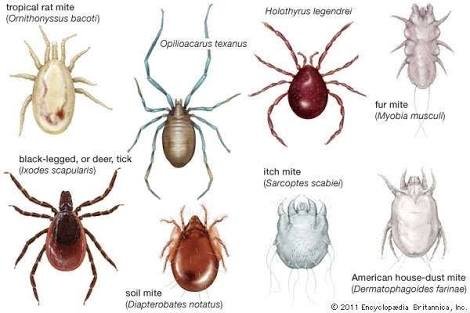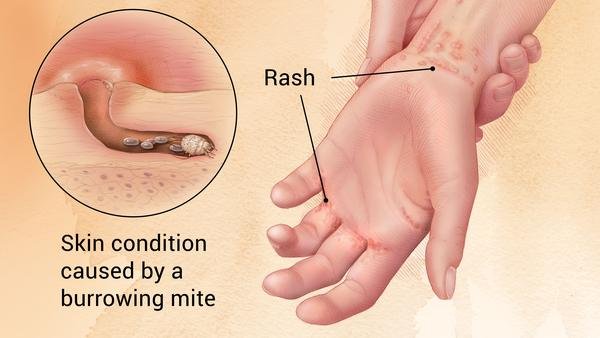Economic Importance of Mites(Acarines)

source
Mites are little anthropods from the acari sub class. They are small insects that are less than 1mm in size and they are mostly observed through the help of a microscope.
Mites are characterized by the division of their bodies into two parts, the cephalothorax and the opiosthoxoma.
Due to their size, Mites are often overlooked by humans and they can live as decomposers in the soil, in plants and also in water depending the specie involved. Some other species of mites are predators or parasites and are known to transmit bacteria to the human body.
Mites cost significant damages to both both plants and animals through bacterial infested bites.
.jpg)
source
Life Cycle
The life cycle of Mites may vary from specie to specie but it generally involves four stages of development into adult life and it happens from ten days to three weeks.
Initially, the female mite lays eggs, usually in a host.
The eggs hatch into larvae that feeds on skin cells of its hosts. This can last between 3 to 4 days.
The larvae then moults into nymphs and undergoes two different stages between the next 3 to 4 days before they finally moult into adult Mites
.jpg)
source
Economic Importance of Mites to plants
The acari family, from which mite comes from, is made up of over 30,000 species
Certain species of mites are important pests of agricultural value. These are mostly known as plant Mites. These mites feed on plants by piercing the cells and feeding on the moisture inside. The most common of these plant mites is known as the spider mite.
.jpg)
spider mites
Spider Mites are mites that attack both indoor and outdoor crops. They are often hard to see with the naked eye and can only be observed keenly by agricultural pest experts.
They live in colonies under plant leaves and feed on the tissues of plants, by piercing and sucking moisture in them. As they continue with this feeding, the leaves of the plants dry up and turn yellowish in colour.
Spider mites are most common in hot, dry conditions, especially where their natural enemies have been killed off by insecticide use. Some of the many species common in North America are predators of the plant-feeding mites, which make up the vast majority. They are also very prolific, which is why heavy infestations often build up unnoticed before plants begin to show damage.Due to the minute nature of spider mites, it is often hard to detect infestation on time but primary detection can be noticed from webs underneath leaves of plants. Symptoms of attack may include, yellow coloring of plant leaves and unusual curl of the leaves as well.
Crops Affected
Acrology studies have shown that spider mites attack the following types of crops.
- Annual vegetable crops like squash, melons and water leaves, which an attack on them reduces significant crop yield.
- Crops like sugar peas and beans where they attack the plant pods.
- Ornamental plants
Control and Elimination of Spider mites
Although the most common control of spider mites are to use pesticides, but that might actually encourage the mite infestation as it kills of other insects that preys on them and they mostly develop resistance to these pesticides. The most recommended methods of eliminating mites are through natural and organic methods.
- Pruning affected plants. The leaves, stem and roots of the affected plants are removed to prevent them from spreading to their healthy neighbours
- Soaking bug blasters in a stream of water can be used to rinse off the mites from the leaves of plants.
- Release of predatory insects like lady bug, lacewings and predatory mice on the plants when the infestation is low can eliminate the mites totally.
- Removal of dusts on plants reduces mite infestation significantly. This can be done by properly watering the plant regularly.
- Use of miticides which are highly recommended from an Agricultural pest expert can go a long way in eliminating them.
Effects of Mites on Animals
Although majority of mite species are harmless, there are also a few of them that transfer bacterial infections to their hosts.
Skin diseases like scabies are caused by bites from mites called sarcoptes scabies which set up shop on the human skin, laying eggs on the layers. This infestation can lead to itching and rashes all over the human body.
It can spread through skin to skin contact from an infected person to healthy persons and also through sexual intercourse. Scabies mites can last up to 3 months in the human body once it enters the body. They usually die within a few hours without human contact.
Prevention and Treatment
Scabies infestation can be prevented by
- Sun drying infected bedding materials and clothes.
- Avoiding contact with an infected person.
- Use of antiseptic soap for body care.
Treatments of scabies can be done through cream treatments like permethrin applied directly to the human body. Treatments should continue for the next 2 weeks.
In conclusion, not all mites are bad for crops, but there is no denying the fact that mites are pests of significant extent to plants as well as animals. Thanks for reading.
.jpg)

Indeed this picture, has caught our eyes, thanks for this beautiful post
Resteem
(to be a part of this community; ensure to always use #farms and #steemchurch for agricultural related post)
SteemChurch Farm (@FARMS)
Nice pic
Plz upvote me
Mites suck!